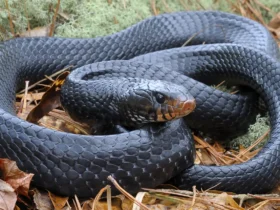The Yellow-bellied Sea Snake (Pelamis platura) is a remarkable creature that captivates marine enthusiasts with its unique characteristics and adaptability to life in the ocean. Known for its vibrant yellow belly, this snake is a true marvel of evolution and a master of its aquatic environment.














Appearance and Distribution
The Yellow-bellied Sea Snake boasts a slender body, measuring around 1.2 meters in length on average, although some individuals can reach up to 1.5 meters. It has a distinct flattened paddle-like tail, which aids in swimming through the water with great efficiency. Its scales are smooth and shiny, enhancing its hydrodynamics.
This species can be found in warm tropical and subtropical waters across the Pacific and Indian Oceans. From the coasts of eastern Africa to Australia, and from Japan to Central America, the Yellow-bellied Sea Snake has established its range in numerous regions, adapting to different conditions.
Adaptations for Ocean Life
The Yellow-bellied Sea Snake has evolved a set of remarkable adaptations that enable it to thrive in its oceanic habitat. Firstly, its tail is perfectly designed for swimming, allowing it to maneuver effortlessly through the water. This snake can swim with remarkable speed and agility, making it a formidable predator.
Another notable adaptation is its lung structure. Unlike terrestrial snakes, the Yellow-bellied Sea Snake possesses a long, tubular lung that allows it to extract oxygen from the air as it surfaces to breathe. This unique adaptation enables the snake to remain submerged for extended periods, conserving energy while hunting and exploring its marine environment.
Feeding Habits
Feeding primarily on small fish and eels, the Yellow-bellied Sea Snake is an expert hunter. Equipped with venomous fangs, it injects its prey with a potent neurotoxin, immobilizing and digesting it. Despite its venomous nature, this snake is not considered a threat to humans due to its docile temperament and the fact that it rarely encounters people in its oceanic habitat.
Reproduction and Life Cycle
The Yellow-bellied Sea Snake follows a unique reproductive strategy known as ovoviviparity. After mating, the female retains the eggs inside her body until they hatch, giving birth to fully formed live young. This adaptation ensures the survival of offspring in the challenging oceanic environment.
Upon birth, the young snakes are self-sufficient and immediately embark on their independent journeys. They possess all the necessary instincts and adaptations required for life at sea, allowing them to face the challenges of the open ocean right from the start.
Interaction with Humans
Although the Yellow-bellied Sea Snake rarely encounters humans, it can occasionally be found washed ashore or entangled in fishing nets. In such cases, it is crucial to handle them with care, as their venomous nature can pose a risk if mishandled. Nonetheless, the species generally poses little threat to humans, and their natural habitat remains the vast expanse of the ocean.
Final Thought
The Yellow-bellied Sea Snake is a captivating creature, adapted to thrive in the depths of the ocean. Its unique characteristics, including its vibrant appearance, hydrodynamic body structure, and venomous adaptations, make it an intriguing subject of study. As we continue to explore and understand the wonders of our natural world, the Yellow-bellied Sea Snake stands as a testament to the remarkable diversity and adaptability of marine life.








